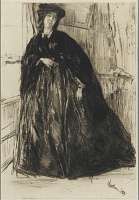Etchings Institutions search term: wunderlich
Finette | ||
| Number: | 61 | |
| Date: | 1859 | |
| Medium: | etching and drypoint | |
| Size: | 293 x 202 mm | |
| Signed: | 'Whistler.' at lower right (3); replaced with new 'Whistler.' at lower right (4-final) | |
| Inscribed: | '1859 -' at lower right (3); replaced with new '1859.' at lower right (4-final) | |
| Set/Publication: | 'Cancelled Plates', 1879 | |
| No. of States: | 14 | |
| Known impressions: | 38 | |
| Catalogues: | K.58; M.58; T.56; W.54 | |
| Impressions taken from this plate (38) | ||
PUBLICATION
EXHIBITIONS
To the Union League Club in New York in 1881, Samuel Putnam Avery (1822-1904) lent three impressions, listed as 'Early trial proof; very rare.' (
 ), 'The same. With additional work; very rare.' (
), 'The same. With additional work; very rare.' ( ) and finally, 'The same. The finished state.' (
) and finally, 'The same. The finished state.' ( ) 27 In 1888, Thomas Glen Arthur (1858-1907) lent an impression to the Glasgow International Exhibition (
) 27 In 1888, Thomas Glen Arthur (1858-1907) lent an impression to the Glasgow International Exhibition ( ). 28
). 28
The artist clearly thought highly of Finette , and when Howard Mansfield (1849-1938), was organising an exhibit of the artist's etchings for the World's Columbian Exposition in 1893, Whistler specifically asked him to include Finette . Unfortunately, as Mansfield explained, he had no frame available. 29
26: Liverpool 1874 (cat. no. 529); see REFERENCES: EXHIBITIONS.
27: New York 1881 (cat. nos. 75-77).
28: Glasgow 1888 (cat. no. 2552-11)
29: Mansfield to Whistler, 15 May 1893, GUW #04002.
 ,
,  ). 30
Bryan Lathrop (1844-1916) lent an impression to the exhibition organised by the Caxton Club in Chicago in 1900 (
). 30
Bryan Lathrop (1844-1916) lent an impression to the exhibition organised by the Caxton Club in Chicago in 1900 ( ). 31 Rather less known, an impression was shown at an international exhibition in Wolverhampton in 1902.
). 31 Rather less known, an impression was shown at an international exhibition in Wolverhampton in 1902.Finally impressions were shown in the principal Memorial Exhibitions after Whistler's death. Four states were on shown at the comprehensive exhibition held in New York at the Grolier Club in 1904, including one proof lent by Freer (
 ), and one, lent by Howard Mansfield (1849-1938), in Boston, also in 1904. 32 Finally, another impression was lent, by King Edward VII, to the London Memorial show in 1905. 33
), and one, lent by Howard Mansfield (1849-1938), in Boston, also in 1904. 32 Finally, another impression was lent, by King Edward VII, to the London Memorial show in 1905. 33
30: New York 1898 (cat. no. 51).
31: Chicago 1900 (cat. no. 50).
32: New York 1904a (cat. no. 56); Boston 1904 (cat. no. ?48)
33: London Mem. 1905 (cat. no. 54).
SALES & COLLECTORS
 ,
,  ), richly inked and dramatic, with prominent burr on the drypoint lines, as well as an impression in the cancelled set, in 1887 (
), richly inked and dramatic, with prominent burr on the drypoint lines, as well as an impression in the cancelled set, in 1887 ( ).
).  ):
): 34: F. Wedmore, 'M. Burty's collection', The Academy , 29 April 1876, pp. 414-415.
However, the rarity of the early states increased their commercial value, and it is clear that Whistler printed only one or two proofs of some states. At some time Whistler gave an impression to a collector, McDougal Smith (
 ). He also kept some early proofs for himself and sold them for higher prices. Ralph Thomas commented:
). He also kept some early proofs for himself and sold them for higher prices. Ralph Thomas commented:35: Sotheby's, 12 June 1877 (lot 102); Christie's, 23 March 1881 (lot 195).
36: Thomas 1874 (cat. no. 58).
37: Sotheby's. 23 April 1887 (lot 407).
38: Hanson to C. Angus, 16 December 1887, GUW #01959.
39: C. Angus, 21 December 1887, GUW #00180.
40: Whistler to C. Angus, 22 December 1887, GUW #00181.
 ).
).41: Sotheby's, 3 March 1892 (lots 104-5).
 ,
,  ,
,  ) and a good impression of the seventh state (
) and a good impression of the seventh state ( ).
).42: Wunderlich's to Whistler, 24 March 1899, GUW #07305.
 ,
,  ,
,  ); Henry Studdy Theobald (1847-1934) (
); Henry Studdy Theobald (1847-1934) ( ); Hermann Heinrich Meier (1845-1905), Bremen, whose wife gave it to the Kunsthalle Bremen (
); Hermann Heinrich Meier (1845-1905), Bremen, whose wife gave it to the Kunsthalle Bremen ( );Howard Mansfield (1849-1938) (
);Howard Mansfield (1849-1938) ( ); Bryan Lathrop (1844-1916) (
); Bryan Lathrop (1844-1916) ( ) and George Washington Vanderbilt (1862-1914) (
) and George Washington Vanderbilt (1862-1914) ( ,
,  ).
). ), and Charles Lang Freer (1856-1919) bought his set from Knoedler & Co. in 1893. Thomas Glen Arthur (1858-1907) also acquired a set in 1887 (
), and Charles Lang Freer (1856-1919) bought his set from Knoedler & Co. in 1893. Thomas Glen Arthur (1858-1907) also acquired a set in 1887 ( ) which later went to Boston Museum of Fine Arts. Other early owners included George Aloysius Lucas (1824-1909) whose set went to the Baltimore Museum of Art (
) which later went to Boston Museum of Fine Arts. Other early owners included George Aloysius Lucas (1824-1909) whose set went to the Baltimore Museum of Art ( ).
).  ). She acquired another set, trimmed the impressions and stuck them on the envelopes containing the copper plates (i.e.
). She acquired another set, trimmed the impressions and stuck them on the envelopes containing the copper plates (i.e.  ).
). 43: Sotheby's, London, 13 December 1889 (lot 787 or 789)

